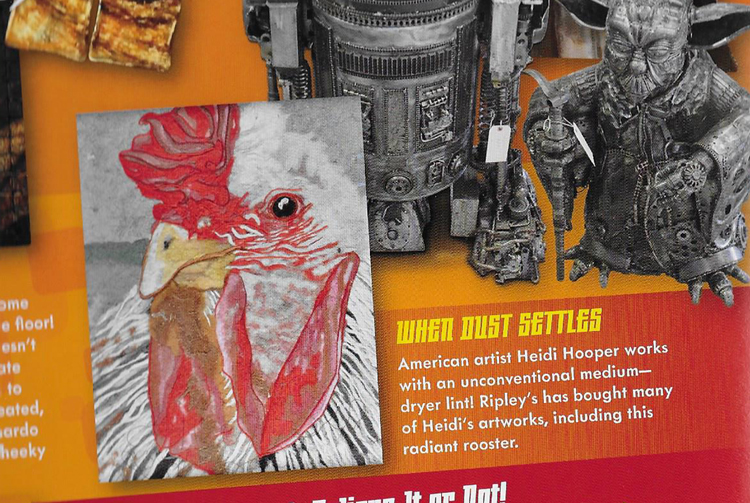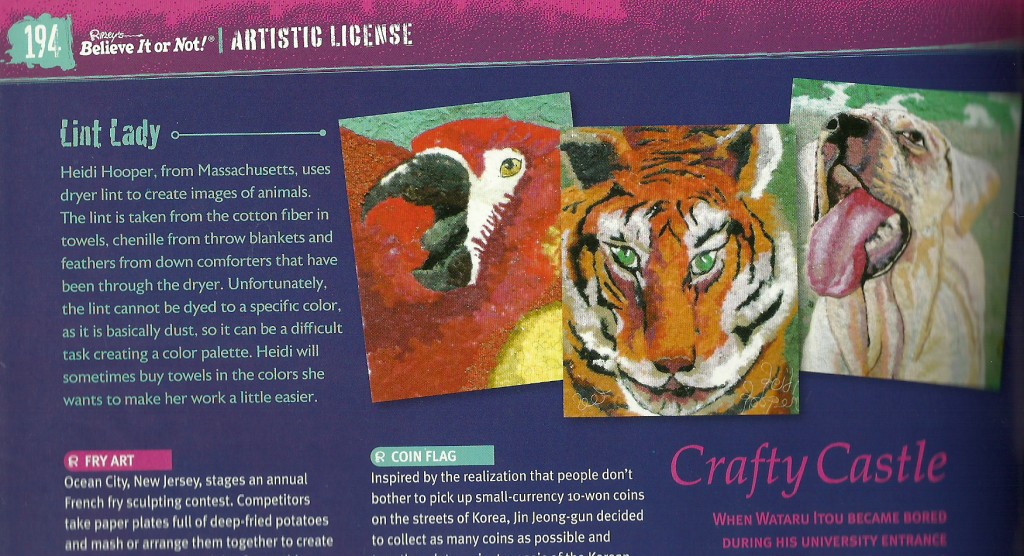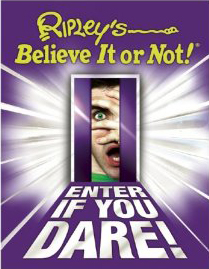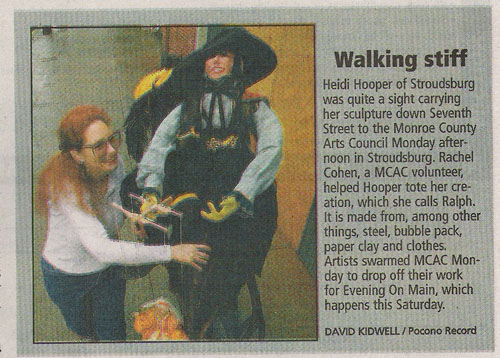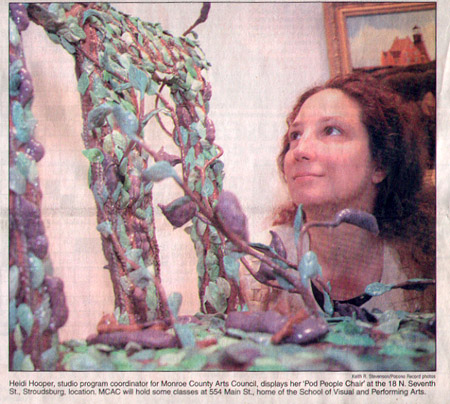Press
Art Talk With April
(October 10, 2023)
Pennsylvania Magazine
(Summer 2023)
The Andy Warhol of Dryer Lint: Artist finds beauty in what others view as trash
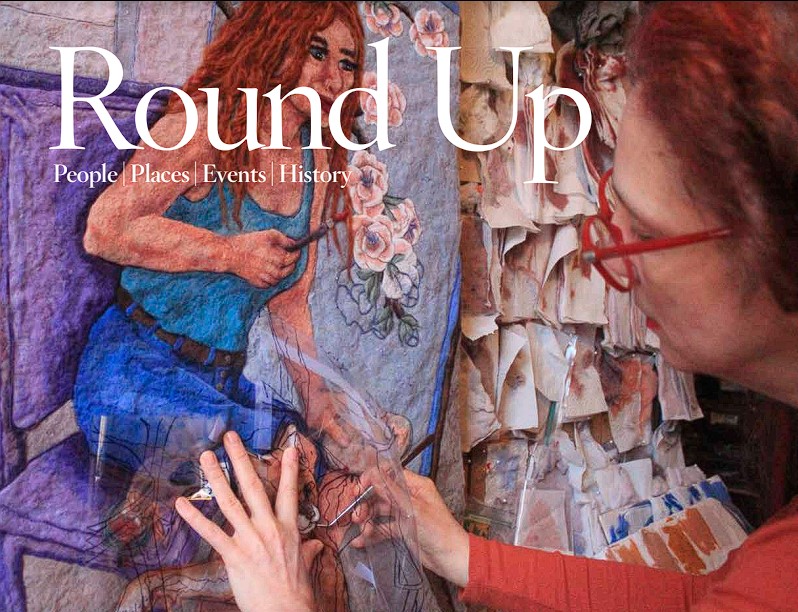
by Cindy Ross
Heidi Hooper did not intend to become what is likely the only dryer lint artist in America. She was merely looking for a way to continue to create in the midst of a debilitating illness.
Hooper, who went to school to learn sculpture and metalsmithing, made beautiful silver jewelry until her work morphed into the unique job of creating armor for female jousters at Renaissance fairs. Then, she fell ill, and her world changed forever. “My first cancer at 34 years old was a doozy—a microscopic desmoid tumor that developed into full-blown cancer when it was radiated,” the Tannersville, Monroe County, artist says. “One in a million gets it. The cancer eats away the muscle and then the radial nerve. There is no muscle left in my arm. It was taken out.” When she tells me to grab her arm, my hand touches right down to bone.
After the same cancer attacked her back, doctors carved out a chunk of her back to provide cover for the loss of the arm muscle.
While sick with cancer, Hooper needed help walking even to the bathroom. Every day for three to four years, she would push herself to complete a task, whether it was washing the dishes or sweeping the floor. In her heart, however, she was a creative person, and she knew she needed to make art again to be truly happy.
Hooper discovered lint as an art medium by accident during her illness. Her mother-in-law was helping with laundry when Hooper noticed a large collection of lint that was shed from rayon chenille blankets accidently thrown into the dryer.
“The lint was multicolored like a rainbow, and when I saw big piles of it sitting on the floor by the dryer, I challenged myself to do something creative with it,” she explains.
She first tried using it to make hand-made paper. While she was experimenting, her husband suggested trying it as paint, something she hadn’t considered since she is allergic to both oil-based and acrylic paint. For two years, she continued to test the medium, which proved a challenge to master. She couldn’t work with it outside since the wind would blow the lint away. She couldn’t allow it to become damp, or it would get moldy.
At first, she used her own lint, making silhouettes more than anything else. Then, someone hooked her up with a laundromat, and she began to collect tubs of lint in her attic. Eventually, she hit on the right combination.
The foundation for her pieces is a foam core board, which she coats with a thin layer of rubber cement. After applying a layer of white lint, she uses tweezers to place colored lint on top. The pieces are tiny, thin and translucent, and the color shows through like a pastel crayon.
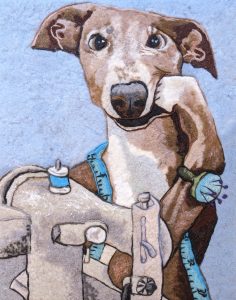
Another of Heidi Hooper dryer lint paintings, “Dina is Not Happy with her New Sewing Machine,” is offered on her website. She has found that others who take up her artform don’t last in the craft if they have the option to use paint, as it’s much quicker process to complete a painting.
“Once the piece is blocked in, it goes a lot faster, except for faces,” Hooper says. “I spend more time stepping back and looking than actually placing the lint.”
She constantly monitors the thickness of the lint to avoid uneven layers, which she thinks make the piece look pitted. A finished piece is about one inch thick.
Stacked floor to ceiling in her Poconos studio and storage rooms are plastic containers filled with colored lint. She typically uses seven large boxes of lint to make a picture, spending about three months to create a large piece measuring 16 by 20 inches and approximately three weeks on an 11-by-14 picture.
When it comes to subject matter, Hooper says, “I have a weird mind. My favorite subject matter is animals doing weird unnatural things. Animals are a hoot, and they make me feel silly. I like my pieces to tell a really good story.”
One of her picture ideas, for example, came from the Cat TV channel, which she puts on to entertain her indoor cats. “Rabbits were running across as a screensaver, birds were flying in and out, and ducks and squirrels were moving about,” she explains.
Hooper, who has been called the “Andy Warhol of dryer lint,” is supported by a far-reaching community of lint donors, ranging from folks down the road to someone who lives in Montana and found her art online. Hooper’s husband, Mike Ventrella, will arrive home every week from his law office, toting a bunch of lint that people have dropped off. To thank her lint donors, Hooper publishes an annual calendar featuring 12 of her latest pieces. “That’s the only way I can keep myself in lint,” she explains. “When I need a certain color, I send out an e-mail with a photo of the color I am running out of, and someone will show up at my door with the needed lint. In a week or two, I have enough to continue.”
The lint comes in a rainbow of colors with golds and yellows the most difficult to find. A gorgeous green comes from one of her lint donors who washes her green doggie bed every week.
Some of her best lint material arrives from a woman who manages costumes on Broadway. To keep the colors vibrant, the garments are soaked in vinegar and fabric softener before washed and tumbled dry.
“I will use everything in my pieces,” she says, from the “schmutz left in people’s pockets like Kleenexes” to cat and dog hair she obtains from a pet groomer. She has even used actual cat whiskers in her pieces. She typically will not use wool lint, however. “Wool bounces,” she says. “A piece will actually move while I am sleeping. It dances and expands.”
Lint has proven to be the perfect material for Hooper since she only has enough arm strength to work with the lightest of mediums. Creating art helps her to forget the pain she has had to endure since her illness.
“I live with constant pain, yet I work every day,” she says. “When working with my art, I get in the zone and am so engrossed that I don’t notice the pain as much. I work until the pain is so bad that I have to stop, usually after four hours.
“You gauge yourself and live accordingly,” she explains. “I know how my body reacts. If there’s a big storm coming and the barometric pressure is bad, I’m out. It hurts then to lift a glass of water. On those days, I watch tutorials all day long and still feel like I did art.”
When she is working on a big piece, Hooper provides daily posts to allow folks to follow her progress online. She also does four in-person demonstrations a year, and every November, she has a three-month show at Gamut Art Gallery in Stroudsburg. Her pieces, which have been displayed at dozens of galleries and shows, typically sell for between $400 and $5,000.
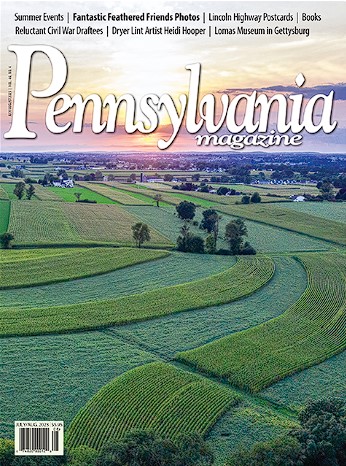 She acknowledges that it took time for the art community to understand and accept her medium. “I entered my pieces in shows as a fiber artist, but it was torture trying to get accepted at first,” she relates. “Many don’t understand the medium. They would advise me to work on my brush strokes! Many galleries don’t want to take the chance with a dryer lint artist since they are unfamiliar with it. I’m odd material.”
She acknowledges that it took time for the art community to understand and accept her medium. “I entered my pieces in shows as a fiber artist, but it was torture trying to get accepted at first,” she relates. “Many don’t understand the medium. They would advise me to work on my brush strokes! Many galleries don’t want to take the chance with a dryer lint artist since they are unfamiliar with it. I’m odd material.”
In recent years, recognition of her art has grown, and she has entered more shows, including the State Museum’s “State of the Art” show in Harrisburg, which features the top 100 artists in Pennsylvania. Her pieces have won numerous awards, and she is at last receiving the accolades she deserves for her one-of-a-kind creations.
“Every now and then, you find another artist attempting dryer lint pictures, but they never last long,” Hooper says. “They’re gone by the next year. Mostly painters try it, but they soon resort back to painting because making a picture with paints is way faster.
“I would make more money if I could use paint,” she admits, laughing. Still, she is content with her medium choice and the artwork that has helped to transform her life.
“I used to be very stressed,” she says. “After so many years of cancer, I thought, ‘Screw it. Whatever happens, happens.’”
What is happening is she is gracing the world with beautiful, unusual dryer lint art.
For more information on Hooper’s art, visit heidihooper.com.
WNEP News
(January 4, 2023)
Jon Meyer met Heidi Hooper, who creates what looks like paintings with a remnant from the laundry
Rambling Rosie’s Vlog
(December 16, 2022)
WMFZ TV Allentown (and other stations around the country)
(October 28, 2021)
Monroe County woman creates artwork using dryer lint
by Holly Harrar
Some of the most creative people find art in unique places. Heidi Hooper found it in the dryer.
Lint, in every color you could possibly imagine.
“People send me their dryer lint from all over the world. I’ve gotten stuff from Australia and London,” Hooper said.
And as recently as Thursday, a donation from a seamstress on Broadway.
When Hooper was diagnosed with cancer, she lost a lot of mobility in her right hand. She was in need of some extra help, and comfort.
That came in the form of chenille throw blankets that got washed and then dried, and then created mounds of lint.
“So I just spent three years while I was sick just trying to figure out something to do with it and I tried everything,” Hooper said.
Not to mention “oddly enough I’m allergic to paint,” she said.
But true artists can find inspiration anywhere.
“So I took that monster and used it as a therapy so that every day it gave me something to strive for,” Hooper said.
She’s made countless pieces, most recently making headlines for a piece she did capturing Saved by the Bell alum Mario Lopez.
“It helps me cope because I have constant pain, so it helps me cope with it,” Hooper said.
Many of her works incorporate her love for cats, and are made with patience, discipline, and passion in each individual fiber.
If you’d like to see more of Heidi’s work, you can go to her website.
Weird Universe
(October 23, 2021)
The Dryer Lint Art of Heidi Hooper
Pocono Record
(October 22, 2021)
Pocono artist commissioned to make lint-based portrait
by Micaela Hood
Some of us consider laundry day a mundane household chore. But Heidi Hooper separates her whites from colors with glee — and purpose.
The Hamilton Township-based artist, known as the “Dryer Lint Lady,” creates art using leftover lint found in the dryer vent.
Yep, those dusty fabrics we discard in the trash (a mix of things from pet hair, towels, blankets, socks) are turned into whimsical portraits of animals and people.
Over the years the pieces, which she makes using fine tweezers to precisely place lint on canvas, have received A-list attention.
This month, Hooper was commissioned by “Access Hollywood,” to create a portrait of the show’s host and “Saved by the Bell” stud, Mario Lopez.
“You should have seen his expression when it was uncovered,” Hooper wrote on her website after the episode aired Oct. 5.
In September her portrait dubbed, “Winter,” (a stunning picture of a woman with a long-haired cat laying on her lap) was one of 100 works featured by the State Museum of Pennsylvania’s during its annual Art of the State exhibition.
Hooper has also appeared as a contestant on the game show, “To Tell the Truth,” in 2018 and featured in Ripley’s “Believe It or Not!,” and Consumer Reports (the magazine dubbed her the “Andy Warhol of Dryer Lint.”)


One of her most treasured accolades came this summer when she accepted the Courage Award for her work with the American Cancer Society at a telethon held in Lansford in August.
Hooper, who formerly sculpted metals with heavy hammers and fire, was diagnosed with a rare microscopic cancer in her right arm in 1999. The dexterity in her body became worse and she ended up undergoing several surgeries and radiation treatments to shrink the tumor.
While she was recovering from cancer, her friends sent gifts to her house including chenille throws with bold hues. A family member, who was helping Hooper around the house while she was in treatment, had accidentally put them in the clothes dryer for too long turning them into burlap.
“I had a huge mound on the floor as well as one on the dryer about the size of collie dog,” Hooper recalled. “I felt bad that friends of mine had bought these beautifully colored throws to cheer me up and within a month I had them completely destroyed.”
Not wanting to part with what was left of the blankets, Hooper spent a few years figuring out what to do with the chenille.
“I didn’t want to feel like I slapped my friends in the face. It may seem like a lame way to get into art, but I was determined to do something positive with it.”
One of her first lint portraits was of a flying pig, a nod to how accomplished she felt at the time.
She’s also made quirky portraits of Andy Warhol, Charlie Chaplin and Vincent Van Gogh’s “Starry Night,” along with ones of furry creatures such as cats, dogs, horses, unicorns and elephants.

Hooper has documented the whole process, which takes roughly three weeks per portrait, on her YouTube channel.
“I take it down to the hairs. You can see through it before I put in on the canvas that’s how thin the hairs are.”
Most of her work is done on 11×14 canvas, but lately her tribute pieces will sell at a larger size (24′ x 36′).
If you’re considered purchasing one of Hooper’s paintings as a gift, she has one piece of advice.
“I always tell this to people whenever they do a commission. You can’t tell anyone or the person what it’s made of. You have make them guess because when they go through the guessing and figure out that it’s dryer lint, the expressions on their face.
“I have yet to have a person not have an outlandish, almost a Mel Brooks-kind of silly face. It’s just complete look of happiness and shock at the same time.”
Hooper’s selected works are currently on display at the Gamut Art Gallery, 109 N. 8th St., Stroudsburg.
Those wanting to donate bright-colored (no gray-colored, please) lint can send it to Heidi Hooper, P.O. Box 333, Tannersville, PA 18372. Pack the lint flat and use a piece of paper to separate each one.
Access Hollywood
(September 30, 2021)
PA Homepage (WYOU TV Scranton)
(September 29, 2021)
Monroe County Artist Turns Dryer Lint into Art
A Monroe County woman with a chronic condition uses a unique and artistic way to cope with her pain.
But it’s not just any ordinary work of art. Her pieces have a purpose.
“They call me the lint lady,” Heidi Hooper said.
Hooper turns clumps of fiber into works of art.
“It really does just kind of blend in instead of standing out,” Hooper said.
The Hamilton Township-based artist is creative. She worked as a metalsmith and sculptor until being diagnosed with a rare microscopic cancer in her right arm in 1999.
“I couldn’t hold a file, let alone wield a hammer. And so each morning while I was sick, I tried something new, until I could find something that would stick,” Hooper said.
That “something” is dryer lint.
“When you get up close you can see, oh yeah, there’s cat hair, there’s pet hair,” Hooper said.
After a 15-year battle fighting the disease, and nearly 20 operations, she’s cancer-free. But the radiation hindered the strength of the most essential tools in her kit: her fingers.
“I have stage two lymphedema, forever. And nerve damage. But, I’m alive,” Hooper said.
Hooper didn’t let anything stop her from finding a new niche. A routine cleaning of her dryer vent led to the discovery of a hobby that would change her life forever and help cope with the effects of the chronic condition.
“I can be hurting like there’s no tomorrow, and just go in there to try to do something for five minutes and the next thing I know, I’ve been there 30 minutes because I got in the zone and I didn’t notice the pain,” Hooper said.
Hooper’s dryer lint art pieces will be on display at the Gamut gallery opening next weekend in Stroudsburg.
American Spark
(September 15, 2021)
Heidi Hooper: Dryer Lint Artist
BRC TV 13
(August 15, 2021)
Heidi Hooper Receives Award at Cancer Society Telethon
Times News
(August 14, 2021)
Five locals set to receive Courage Award at telethon
by Justin Carlucci and Terry Ahner
The Tamaqua-Carbon American Cancer Society will hand out its annual “Courage Awards” this weekend during its annual telethon at Penn’s Peak in Jim Thorpe.
Recipients are Heidi Hooper, of Tannersville; Dawn Ferrante Hart, of Wallenpaupack; Tom Connors, of Weatherly; Jillian Datchko, of Tamaqua, and Sierra Thomas, of Summit Hill.
Heidi Hooper never gave up. The only way to stop the cancer was receiving a ton of radiation, which essentially left her incapable of using one of her arms.
“Sometimes I still get choked up,” Hooper said. “I was only like 35 and I lost everything. I was just starting to get on my feet as a business and all the sudden, I couldn’t do it anymore. Every day, I tried something that I didn’t know how to do. I’d try it for a week, if it wasn’t my thing, it wasn’t my thing.”
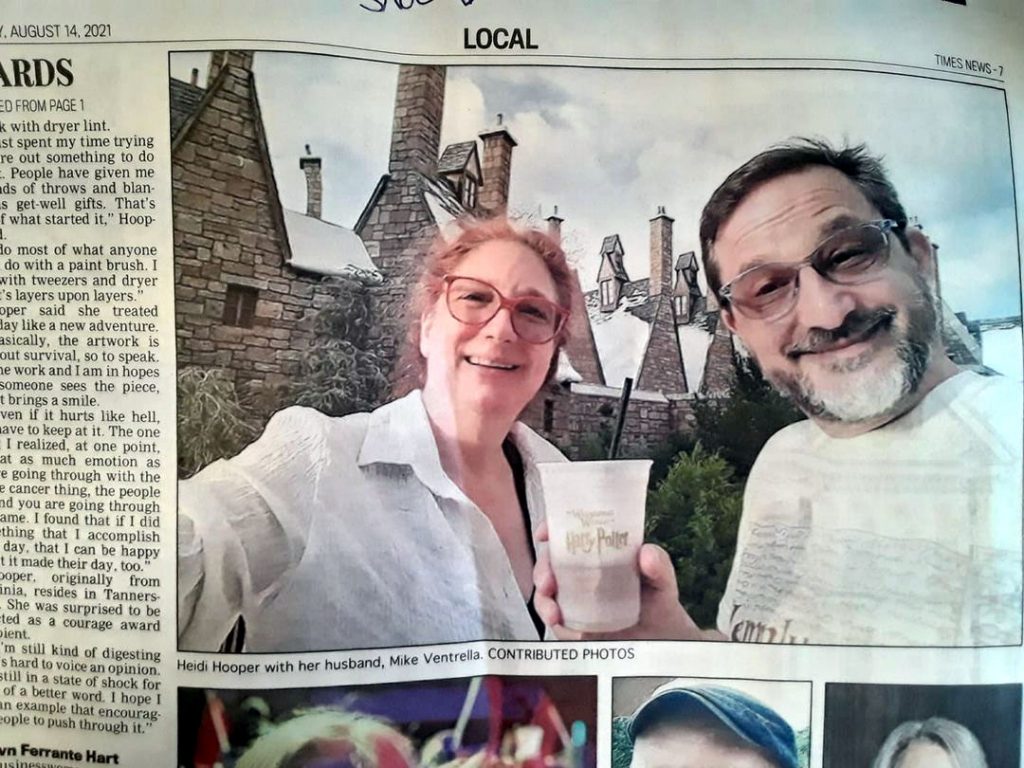 Hooper used to make metal armor for female jousters, but due to cancer, can barely use her fingers. She kept working to find a niche skill – and she found it.
Hooper used to make metal armor for female jousters, but due to cancer, can barely use her fingers. She kept working to find a niche skill – and she found it.
Hooper makes phenomenal artwork with dryer lint.
“I just spent my time trying to figure out something to do with it. People have given me all kinds of throws and blankets as get-well gifts. That’s kind of what started it,” Hooper said.
“I do most of what anyone would do with a paint brush. I do it with tweezers and dryer lint. It’s layers upon layers.”
Hooper said she treated each day like a new adventure.
“Basically, the artwork is all about survival, so to speak. I do the work and I am in hopes that someone sees the piece, that It brings a smile.
“Even if it hurts like hell, you have to keep at it. The one thing I realized, at one point, is that as much emotion as you’re going through with the whole cancer thing, the people around you are going through the same. I found that if I did something that I accomplish each day, that I can be happy about it made their day, too.”
Hooper, originally from Virginia, resides in Tannersville. She was surprised to be selected as a courage award recipient.
“I’m still kind of digesting it. It’s hard to voice an opinion. I’m still in a state of shock for lack of a better word. I hope I am an example that encourages people to push through it.”
BRC TV 13
(August 12, 2021)
Courage Award Winner Heidi Hooper
This weekend is our annual American Cancer Society Telethon right here on Channel 13. Every year we highlight Courage Award winners who have either beaten cancer or are still fighting. News13’s Nicole Walters introduces us to Heidi Hooper from Heidi Hooper.
Heidi Hooper makes stunning portraits out of the stuff you discard from your dryer vent drawer. She discovered that talent by default. Hooper was a metalsmith who made armor for jousters at renaissance fairs she felt a pain in her upper arm that she says she knew wasn’t right.
Hooper explains, “I just kept going from doctor to doctor to doctor until I finally had somebody that said I think this might be something else.”
It turned out to be a new rare microscopic cancer that takes a chemical MRI to see it.
Hooper says, “I’m the patient zero from Desmoid Tumors to Desmoitosis so when they hit it with the radiation, instead of killing it, it basically killed the center and the other two sides split and moved up and down my arm.”
She was diagnosed in 1999 and spend the next 15 years battling the disease in different parts of her body and enduring around 20 operations. Over that time, her dexterity and strength became worse and worse. Since Hooper could no longer use a hammer to make the armor, she kept trying to find something she could do and not let cancer defeat her. That ended up being dryer lint.
Hooper says, “I have so little grip that I can actually take the dryer lint with tweezers down to like hairs hanging on one another and that’s how I do the shading on the pieces to make it kind of look like paint.”
Now fans from all over the world buy her artwork and send their link. It’s categorized and takes up an entire closet in her home. She’s won many awards and her pieces are displayed in art galleries throughout the country. Turning trash into cash is only one of the ways she proves anything is possible.
Hooper says, “ Life is a journey so it has ups and downs and you just go with the flow one day at a time.”
Currently she has to wear a compression sleeve on her arm at all times for her Lymphedema caused by radiation. But she has been cancer free for the past three years. That wouldn’t have happened if she had gone with what the first doctor told her.
Hooper adds, “That was the thing that I learned with the cancer, you got to push, you got to keep pushing and be heard, even if you feel like you’re being obnoxious.”
You can watch Heidi Hooper and our other Courage Award recipients on August 14th and 15th from noon to midnight on Blue Ridge Channel 13.
THE CIRCLE
(March 8, 2021)
Dryer lint artist Heidi Hooper is out to prove that one man’s trash is another man’s treasure
by Tunee Tobias
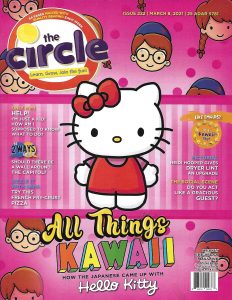
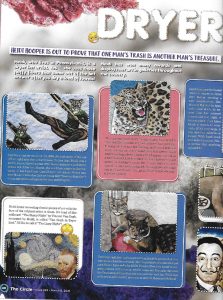
 Heidi, who lives in Pennsylvania, is a dryer lint artist. Yes — she uses those fluffy fibers that come out of the lint drawer after you dry a load of towels! Heidi has won many awards and displays her art in galleries throughout the country.
Heidi, who lives in Pennsylvania, is a dryer lint artist. Yes — she uses those fluffy fibers that come out of the lint drawer after you dry a load of towels! Heidi has won many awards and displays her art in galleries throughout the country.
Heidi is a cancer survivor. In 1999, she lost most of the use of her right arm due to her illness. Before that, Heidi was a smith; she sculpted metals with heavy hammers and fire to create art. After her illness, she could no longer sculpt because of her handicap. Unwilling to let cancer defeat her, now Heidi creates her lint art using tiny tweezers that don’t strain her arms and hands the way smithing did.
No copycats here! Even though others have tried to copy Heidi’s dryer lint art, most of them have given up. It takes hard work, organization, and lots of trial and error to make are out of something that artists know nearly nothing about (unless they happen to work at a laundromat). Heidi worked on may pieces that got ruined or damaged; dryer lint is very delicate. Now that she is more experienced, Heidi knows what she can and can’t do with the lint and how to make beautiful masterpieces.
Heidi is a purr-fectionist when it comes to dryer lint! Before starting a new masterpiece, Heidi sorts the lint by type, color, and shade to ensure that her artwork comes out just right. A typical piece of art takes Heidi a month to complete; if it’s very large, it can take two months or longer. With hard work and determination, Heidi proves that anything is possible!
Heidi started out using about 10 – 20 different boxes of colored lint; now she has over 1,000, which she feels has enhanced her artwork tremendously. None of the dryer lint is dyed. Every color you see if straight from the dryer lint onto the canvas!
How does she get all these bright, beautiful colors when our dryer lint is always a boring gray? “I buy colorful towels!” says Heidi, “but 95 percent of my lint comes from fans all over the country, and a few from other countries. Without them, I’d never be able to do this work … After all, it’s not like I can go to the art supply store to buy more!” Every year, Heidi rewards those who send her “good” dryer lint with signed prints, cups, and other merchandise with her artwork on it.
Heidi loves recreating classic pieces of art with the face of the original artist in them. It’s kind of like selfie art! “The Starry Night” by Vincent Van Gogh, recreated by Heidi, is called “Van Gogh in Dryer Lint.” I’d like to call it “The Linty Night!”
Turning trash into cash is something Heidi is proud of. A custom piece of art from Heidi, like the portrait of someone’s pet cats shown here, sells for $350. People often hire Heidi to create portraits of their pets, which come out fantastic because the fuzziness of dryer lint mimics animals’ soft fur. Heidi also sells art in galleries for as much as several thousand dollars!
In case you haven’t noticed yet, Heidi is crazy about cats! “Cats make me happy,” Heidi comments, “so I like to feature them in my work, and I think it makes the work more fun. Heidi has four cats with four interesting names: Doctor Who, River Song, Mrs. Premise, and Mrs. Conclusion.
Heidi’s biggest challenge in lint art? “It’s very time-consuming!” she confesses. It’s also frustrating when people don’t treat it like real art. Heidi wants everyone to know that
“anything can be art!” even something as disposable as dryer lint. Heidi also believes that anyone can be an artist. “You just have to find the kind of art that is right for you.”
Press
PLANET SHIVERS PODCAST
(December 28, 2020)
60 SECOND DOCS
(October 3, 2019)
VCU ALUMNI NEWSLETTER
(January 10, 2019)
The art of the unraveled: Arts alumna used dryer lint to rescue her artistic career, save herself from depression and create beautiful and unusual new work
By Erica Naone

Artist Heidi Hooper (B.F.A.’81/A) was a metalsmith until an illness forced her to forge a unique new artistic career.
Heidi Hooper (B.F.A.’81/A) was a metalsmith working and teaching classes in the late ’90s in Boston before a cancerous tumor ate away the strength of her right arm. Her artistic metal armor pieces had won costuming awards all over the world, including at WorldCon, an annual conference that offers some of the most prestigious awards in science fiction and fantasy circles. Her illness stunned her and seemed to signal the end of her artistic career.
“I had been hammering eight to 10 hours a day,” Hooper says. “[The illness] was a huge jolt. It became so I struggled to hold a glass of water, let alone a hammer.”
Cancer treatments destroyed most of the muscles in her upper arm and left lymphedema, painful swelling, in their wake. Hooper searched for a way she could still create, but even working with material such as soft clay was painful.
“In order to keep from getting too depressed, each day I gave myself something new to try, whether it was artistic or just cooking an egg,” Hooper says.
Inspiration struck in the odd form of guilt. Friends had given Hooper some soft chenille throws to comfort her through the cancer treatments, but a well-meaning helper accidentally destroyed them by putting them in the dryer. “There was lint the size of two collie dogs,” Hooper says. “I felt really bad for the people who bought me these nice, beautiful, colorful chenille throws to cheer me up. I felt I had to do something with them.”
In the early 2000s, she began the painstaking process of learning to make art from dryer lint, creating pieces that she describes as “horrible” at first. She and her husband had moved to the Pocono Mountains of Pennsylvania by then, and Hooper experimented in her home studio.
Hooper credits her time at the Virginia Commonwealth University School of the Arts with giving her the skills she needed to make her new medium work. “The sculpture department goes out of their way to try and have you learn every possible technique, even if you’re doing it for only one day, just to get the feel of different stuff,” she says. “That’s what I pulled on.”
Gradually, Hooper shaped the process she uses today. She draws a sketch of what she wants to create, takes a photo of the sketch for reference and covers it with archival tacky. She then layers colored lint on top of the glue until it’s a half-inch to an inch thick. She photographs the piece at this point so she can make prints. After that, she covers it permanently with glass for protection.
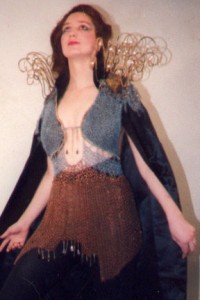
Heidi Hooper (B.F.A.’81/A) wears a suit of fantasy armor she created. Before her illness, she was known for her metalwork in the science fiction and fantasy convention circuit.
She began receiving beautifully colored lint from costumers and other fabric enthusiasts. Many of the people she knew from the science fiction conventions she visited with her fantasy armor were excited about her new artistic direction. Hooper says these people get vivid colors out of their dryers, rather than the nondescript gray that’s produced by, say, an unsorted wash or clothes that have seen better days. Word spread through the convention circuit and also as her art became known. Hooper says she now receives the equivalent of a small suitcase full of lint each month, which she keeps organized by tone and shade in a collection that has grown to nearly 800 repurposed plastic salad boxes.
“It was trial and error,” Hooper says. “It wasn’t a thrill or an excitement until it started working because I wasn’t where I wanted to be. I was determined to keep going and keep trying new things until I got something that worked.”
Hooper’s break came not long after she sorted out the process. Ripley’s Believe It or Not found examples of her work online and contacted her asking to purchase some. Her art now appears in Ripley’s museums around the world as well as in books the company produces.
Since then, she has made dryer lint art into a career. She sells commissioned pieces for about $350 each, offers prints as a reward to fans who donate small monthly sums to her through the website Patreon and sells completed pieces through her website and in galleries for as much as several thousand dollars.
Hooper’s work is on exhibit at Gamut Art Gallery in Stroudsburg, Pennsylvania, in a show that opened Dec. 6 and continues through the beginning of March. Gallery curator Jim Evanisko says he was introduced to Hooper by another local artist. He was intrigued enough to visit her home studio but wasn’t prepared for what he saw when he arrived. “She’s got so much talent, it caught me off guard,” Evanisko says.
Evanisko had gone to see Hooper’s lint work, but as he walked through the house, he saw examples of her entire artistic career, including ceramics, silverwork and dolls and puppets, some from before her illness and some from the period in which she searched for a medium she could use to make art without too much pain.
“This was just too much to waste,” he says.
As a result, the show at Gamut Art Gallery includes art from various stages of Hooper’s life and work.
“My favorite thing about her is her sense of humor and the way she takes life,” Evanisko says. “With the hell she’s gone through, it just amazes me.”
He recalls a recent afternoon when Hooper came by the gallery to drop off a new work for sale in the show, “The Bride of Frankenstein’s Cat,” created from dryer lint. “It was absolutely terrific,” Evanisko says.
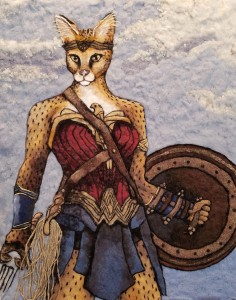
This portrayal of Wonder Woman by artist Heidi Hooper (B.F.A.’81/A) shows the superhero as a cat and is made of painstakingly layered dryer lint.
Cats are a common theme in Hooper’s work. Portraits of pets are a solid source of regular income for her as the fuzziness of dryer lint lends itself well to portraying soft animals. Beyond that, she has envisioned superheroes, such as Wonder Woman, as cats and is working on a picture book that plays on words that include “cat,” such as “catfish” and “catatonia.”
Her five cats, McGonigal, Doctor Who, River Song, Mrs. Premise and Mrs. Conclusion, she says, have offered both succor and inspiration.
“There’s so much cat stuff because whenever I have to lie down and rest, the cats just pile on me. They’re a super comfort and part of my daily routine,” Hooper says.
Hooper is not currently undergoing cancer treatments, but her stage 2 lymphedema requires her to hook into a machine that massages her arm to lower the swelling four times a day. The pain from that condition allows her only a precious few hours of working time a day, but she tries to make the most of them.
The quirkiness of her work has given her a reputation as “the lint lady,” but Hooper has also enjoyed prestigious recognition for her art. She won the Niche Award in 2014 for a large dryer lint piece featuring pop artist Andy Warhol, and again in 2017 for a piece honoring the surrealist artist Rene Magritte.
Hooper often says that, whatever comes, the “monster inside her” will continue to demand that she create, and she will find a way to do it.
MODERN ROGUE
(November 21, 2018)
5 People Who Create Art In Fascinating Ways
by Dwayne Hoover
Dryer Lint: It’s Not Just For Your Belly Button
Typically, dryer lint is good for only one thing: Throwing in the trash. It resides in a screen or a navel until you dig your finger in there and carry it to its temporary resting place before hitching a ride to Landfilltown. Landfillburg? Whatever. Good riddance, lint.
Heidi Hooper doesn’t share the same sentiment, though – when she sees dryer lint, she sees gold. Or at least art material, because she uses it to create some pretty impressive works. How does she do it? I’m glad you asked!
It looks like pretty intricate work, but that’s not even the question I had — Where in the hell does she get that much lint? Is she … does she have a basement filled with dryers that she’s constantly throwing single colored shirts in? Does she ask for donations? Did she open Dryer Link Market where fellow lint enthusiasts can buy, sell and trade the stuff?
Dibs. I call dibs on that idea, and I’m going to open it right next door to a Michaels.
HERCULES MAGAZINE
(October 2018)
Dryer lint artist gets brush with fame on “To Tell The Truth” TV show
On June 17, 2018, Heidi Hooper was a contestant on ABC’s “To Tell the Truth” as celebrity judges including actor and director Mel Brooks were asked to determine which of the three contestants was the real award-winning dryer lint artist.
How did you first begin working with dryer lint and creating artwork?
I have a Bachelor’s Degree in Sculpture from Virginia Commonwealth University and a Masters in Metalsmithing from Massachusetts College of Art. In 1999, I was afflicted with cancer, which limited use of my right arm. So instead, I started looking for something else to fulfill my artistic needs.
How do you obtain all the lint that you use for your artwork?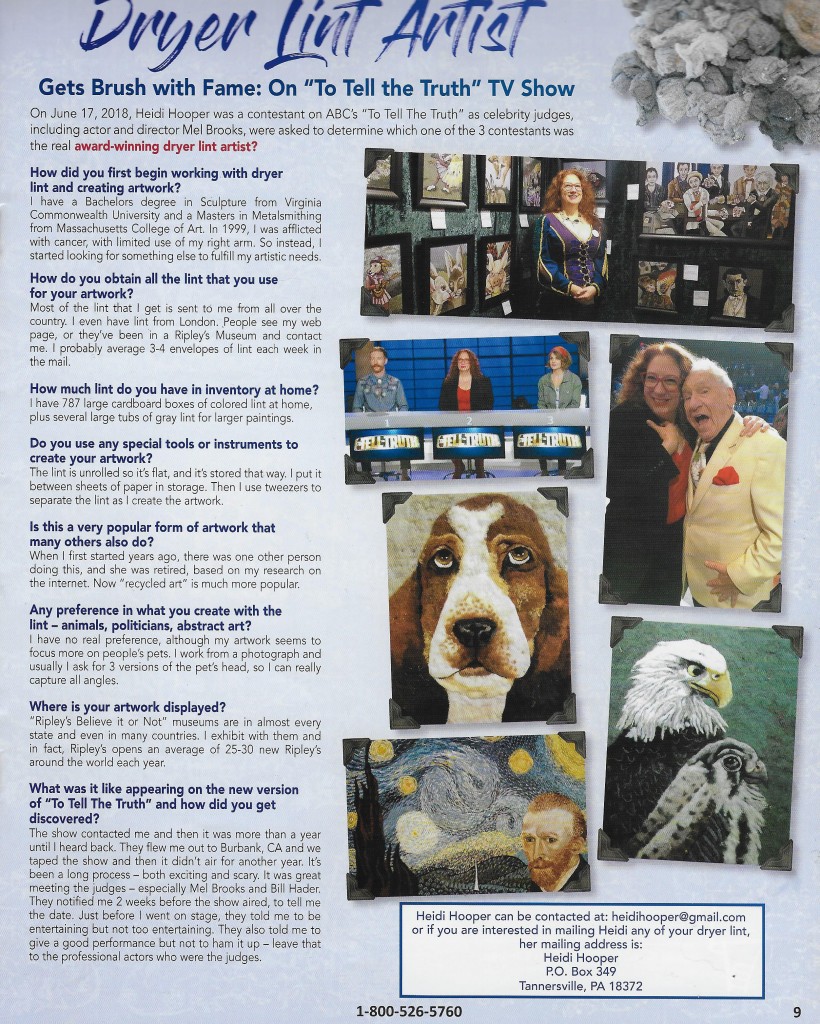
Most of the lint that I get is sent to me from all over the country. I even have lint from London. People see my web page, or they’ve been in a Ripley’s Museum and contact me. I probably average three to four envelopes of lint each week in the mail.
How much lint do you have in inventory at home?
I have 787 large boxes of colored lint at home, plus several tubs of gray lint for larger work.
Do you use any special tools or instruments to create your artwork?
The lint is unrolled so it’s flat and it’s stored that way. I put it between sheets of paper in storage. Then I use tweezers to separate the lint as I create the artwork.
Is this a very popular form of artwork that many others also do?
When I first started years ago, there was one other person doing this, and she was retired based on my research on the internet. Now “recycled art” is much more popular.
Any preference in what you create with the lint? Animals, politicians, abstract art?
I have no real preference, although my artwork seems to focus more on people’s pets. I work from a photograph and usually ask for three versions of the pet’s head so I can really capture all angles.
Where is your artwork displayed?
Ripley’s Believe it or Not Museums are in almost every state and even in many countries. I exhibit with them and in galleries.
What was it like appearing on the new version of “To Tell The Truth” and how did you get discovered?
The show contacted me and then it was more than a year until I heard back. They flew me out to Burbank, California, and we taped the show and then it didn’t appear for another year. It’s been a long process — both exciting and scary. It was great meeting the judges, especially Mel Brooks and Bill Hader. They notified me two weeks before the show aired to tell me the date.
Just before I went on stage, they told me to be entertaining but not too entertaining. They also told me to give a good performance but not to ham it up — leave that to the professional actors who were the judges.
Press
ARTSY SHARK MAGAZINE
(October 10, 2018)
Heidi Hooper creates richly textured and intriguing art made with dryer lint
Dryer lint?
Yes, seriously. I make art out of dryer lint. I never expected to, but I ended up there after I had to find a new medium.
I am a graduate of Virginia Commonwealth University’s sculpture department, and studied for my Master’s degree at University of California Long Beach and then later at the Massachusetts College of Art (where I also taught for a while). Then, around 1999, I was diagnosed with a cancerous tumor that eventually ate away my upper right arm muscle. After years of radiation treatments and numerous surgeries, I found myself handicapped to the point where I could hardly use my right arm.
I had to find a way to make art. The monster inside of me demanded it.
I tried many different media, and after trying various fabrics and paper, and in a move that surprised even me, ended up making art from dryer lint. I liked working with the textures, and had to teach myself the techniques needed to make it look great. As I progressed, my work became increasingly complicated and more detailed.
I have since become the world’s premier dryer lint artist. Consumer Reports calls me “The Andy Warhol of Dryer Lint.” Ripley’s Believe it or Not features my work in their museums and in their books. I’ve won two national Niche Awards for my portraits of famous artists.
And in just the past few months, I was a guest on ABC TV’s TV show “To Tell The Truth” where the panelists (including Mel Brooks) had to guess which one was the real dryer lint artist.
My health is still poor. I can only work a few hours per day and then have to rest. My lymphedema requires me to get into a machine every once in a while to prevent the arm from swelling. And even then, it’s not always successful. I’ve had many hospital stays when the cellulitis acted up, causing an infection.
A lot of my work is commissions. People like getting pictures of their pets in dryer lint, and the medium works well for fuzzy animals. I like to do themes for much of my work. I do tributes to artists I admire, which have sold for thousands of dollars each.
I also like doing peacocks using real peacock feathers, and I recently completed a series of super hero women as cats. People often ask how I dye the lint, but I don’t. You really can’t dye what is essentially dust, and even if you did, it would smear onto the glass that covers the piece. I need lint to come out of the dryer that color.
Most of my best lint comes from people who mail it to me. I have costume designers who send me great lint in various colors, because most of mine comes out gray. I always thank those who send me lint with a signed print at the end of each year.
I have a huge walk-in closet with a very tall ceiling that stores the lint. I sort it by color, laying it out in flat sheets, and then keep it in plastic containers. The hard part is keeping the cats from jumping on the boxes and spilling the lint all over the floor.
THE HEALING POWER OF ART
(August 8, 2018)
Heidi Hooper’s Determination to Create Art Led to World-Wide Acclaim
This article by Heidi Hooper is about her passion and fortitude to create art in spite of obstacles and how it led to world-wide acclaim. After having achieved many accolades as a metalsmith artist, she was faced with cancer which left permanent damage to her arm. She could no longer work in that medium. Her persistence led to her becoming a world-acclaimed, award-winning artist known as “The Andy Warhol of Dryer Lint.” She proves that her innate talent, courage and fervor harvest unlimited potential. This article is part of our inspirational series of “Artists’ Stories”.
About Heidi Hooper: She graduated from Virginia Commonwealth University’s sculpture department and studied for her Master’s Degree at UCLA in Long Beach and the Massachusetts College of Art in Boston — where she also taught. Her work has been shown in many galleries throughout the U.S. including 433 Main Street Gallery, Stroudsburg, PA; A Mano Gallery, Lambertville, NJ; and Anderson Gallery, Richmond, VA. Her numerous awards include Judge’s Choice Award, Philcon Science Fiction Convention, Philadelphia, PA; Monroe County Image Award, Community Arts, Stroudsburg, PA; Best Fiber, Niche Magazine Award, Philadelphia, PA; among others. Visit her website HeidiHooper.com to see her work.
Since the removal of most of my right arm muscle to cancer, I thought my career as an artist – a metalsmith and jeweler – had ended. I had to heal myself somehow, because I needed to create, handicapped as I was. The monster within me demanded it.
I tried many different media, and in a move that surprised even me, ended up making art from dryer lint. I liked working with the textures, and had to teach myself the techniques needed to make it look great. As I progressed, my work became increasingly complicated and more detailed.
I have since become the world’s premier dryer lint artist. Consumer Reports calls me “The Andy Warhol of Dryer Lint.” Ripley’s Believe it or Not features my work in their museums and in their books.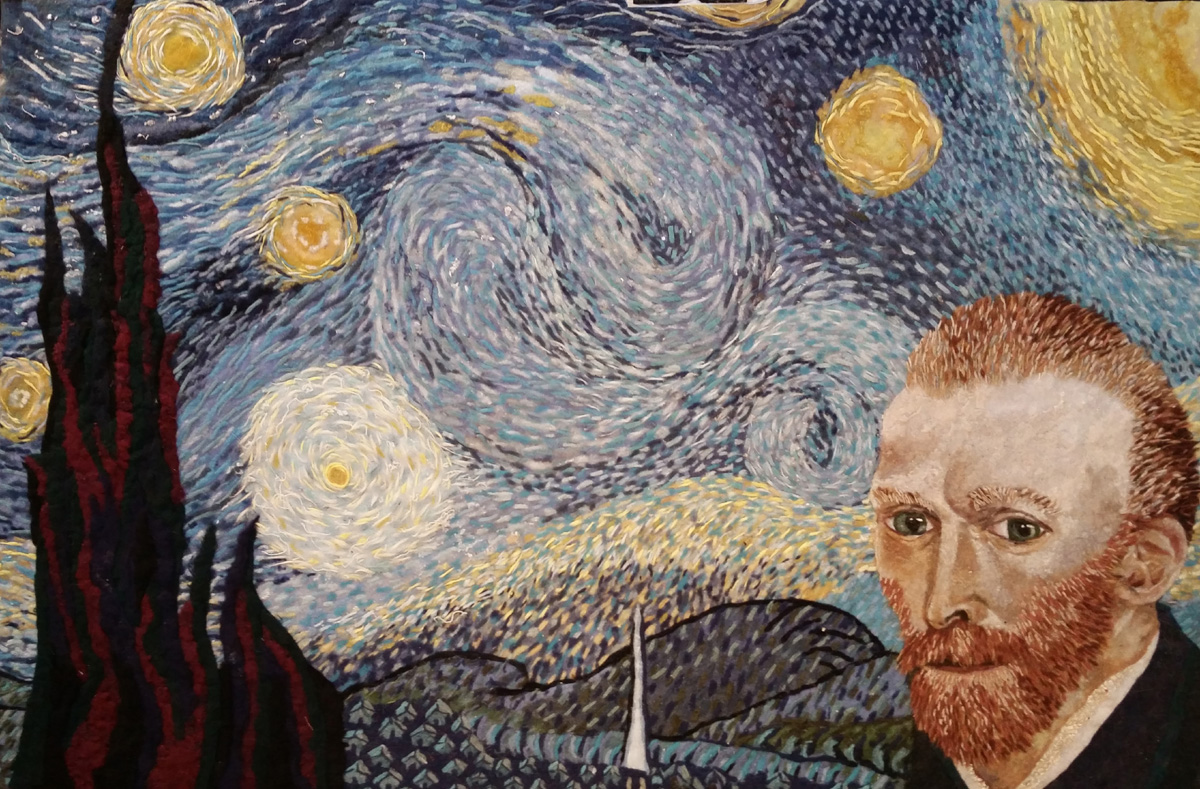
And in just the past few months, I was a guest on ABC TV’s TV show “To Tell The Truth” where the panelists — including Mel Brooks — had to guess which one was the real dryer lint artist.
My health will never be great. I have lymphedema and must get into a machine every once in a while to prevent the arm from swelling. And even then, it’s not always successful. As I write this, I am recuperating from another week-long stay at the hospital when the cellulitis acted up, causing an infection.
After so many years of sadness with my cancer treatments, I like to laugh. It pleases me when people say “dryer lint?” It’s definitely funny to consider what the art is made of, and my work has always had that thread of humor throughout it. Hopefully this is obvious in my work.
I like to do themes for much of my work. I do tributes to artists I admire, and these have sold for thousands of dollars each. I also like doing peacocks using real peacock feathers, and I recently completed a series of super hero women as cats.
A lot of my work is commission – people like getting pictures of their pets in dryer lint, and the medium works well for fuzzy animals.
People often ask how I dye the lint, but I don’t. You really can’t dye what is essentially dust, and even if you did, it would smear onto the glass that covers the piece. I need lint to come out of the dryer that color.
Most of my best lint comes from people who mail it to me. I have costume designers who send me great lint in various colors, because most of mine comes out gray. I always thank those who send me lint with a signed print at the end of each year.
I have a huge walk-in closet with a very tall ceiling that stores the lint. I sort it by color, laying it out in flat sheets, and then keep in it plastic containers. Then the hard part is keeping the cats from jumping on the boxes and spilling the lint all over the floor.
Heidi Hooper
WBRE
(June 18, 2018)
Dryer Lint Artist from the Poconos Makes Game Show Debut
by Carmella Mataloni
Heidi Hooper from Stroudsburg can usually be found in her living room, tweezing away.
“Everyone just assumes it’s a painting and they get up close and closer and it’s like, ‘oh, it’s handmade paper, really good handmade paper,’ and then they get up close and it’s like, ‘oh, my!’”
It’s dryer lint.
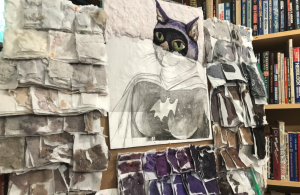
Heidi uses the laundry waste to make works of art.
Sunday night, her talent earned her a spot on ABC’s game show “To Tell the Truth.”
“Oh, I was scared stiff. I am not one of these on the stage. Well, yes, I am a costumer and I go on stage a lot, but it’s different when you’re on TV and it really made me a nervous wreck but everyone was super sweet and they were really nice,” said Hooper.
Heidi has been making dryer lint art for the past ten years. She has won several awards and has created thousands of pieces.
“I had a lot of lint and just challenged myself to see what I could do with it,” said Hooper.
Now if you’re wondering where Heidi gets all of her lint to make art, the answer is from all around the world. In her lint room, more than 700 boxes of colored lint are stored.
“You can see like some of the colors these costumers send me and quilters, I mean I am just floored,” said Hooper.
And even though special guest panelists, including actor and director Mel Brooks, were able to pick Heidi has the true artist, she says it was an experience she will never forget.
ABC TV
(June 17, 2018)
To Tell the Truth
THE POCONO RECORD
(June 17, 2018)
Local artist’s game show appearance airing Sunday
by Andrew Scott
Who would’ve ever thought art work could be created from something as disposable as lint from a laundry dryer?
Yet, dryer lint has become a medium used by an increasing number of artists in recent years.
One such artist lives right here in the Poconos. In fact, Heidi Hooper of Stroudsburg has had two of her dryer lint pieces, “Andy Warhol” and “Magritte,” win the Niche Award, Niche Magazine’s annual recognition of American and Canadian achievement in fine craft.
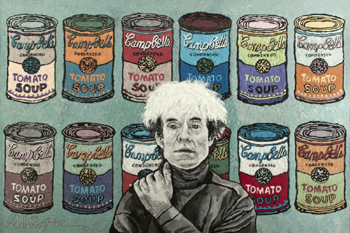
Artist Heidi Hooper’s “Andy Warhol in Dryer Lint” won the 2014 Niche Magazine Award. Hooper, of Stroudsburg, is a featured guest on “To Tell The Truth” celebrity game show set to air at 10 pm Sunday, June 17, 2018, on ABC.
Hooper’s fame has made her a featured guest on an episode of the celebrity game show, “To Tell The Truth,” filmed last summer and airing at 10 p.m. Sunday, June 17, on ABC-TV.
Currently hosted by actor Anthony Anderson, who’s accompanied by mother Doris “Momma” Anderson, the show features two groups of people.
One group has three people. One of the three has an unusual occupation or talent and the other two are professional actors or impostors both pretending to be that person.
The people in the other group, one of whom is a guest celebrity, are competing against each other to guess the two impostors apart from the real person.
Hooper is featured as the real person being impersonated by two actresses in the episode airing Sunday. In the group guessing is comedian, actor and movie director Mel Brooks, whom she got to meet personally.
“Mel is just as nice in real life as he is on stage,” Hooper said. “A woman in his group got the right answer before he did. He was just the loudest one in their group. And Anthony is a sweetie. Plus, I got to hug ‘Momma.’”
Hooper’s road to rubbing shoulders with celebrities began with her childhood passion for art.
“I carved sculptures out of soap when I was 10,” she said.
As she grew older, Hooper experimented with various traditional and less traditional art media.
“Except paint,” she said. “I’m actually allergic to paint.”
In 1999, the right-handed Hooper was diagnosed with a form of cancer in her right arm. This kept her from using metal, the medium she was working with at the time.
Hooper’s mother-in-law, herself battling lupus at the time, looked after her.
“Since I couldn’t work with metal any more, I had to see what other media I could play around with,” she said. “One day, my mother-in-law almost destroyed blankets she had in our dryer.”
Hooper noticed the colorful lint left behind and wondered.
“At the time, I could find only one other artist who had ever worked with dryer lint,” she said. “She turned out to be an elderly woman who wasn’t doing it any more.”
Hooper’s experimentation eventually led to the pieces that can now be seen on her website, http://heidihooper.com/dryer-lint-art/. One, “Obama,” depicts the former President and an elephant.
“That’s my favorite for obvious reasons,” the registered Democrat said.
Another personal favorite is “Red Sonja.” This is part of a series featuring famous superheroines, such as Wonder Woman and Supergirl, depicted as felines in their iconic costumes.
As for the cancer, doctors in 2010 finally managed to permanently remove all of it from inside Hooper’s arm, just as it was about to start eating into the bone. Hooper had to have reconstructed nerves attached to the bone.
“It was art that helped me get through that 11-year battle with cancer,” she said. “Art and my pig-headed stubbornness.”
If there’s a message Hooper’s art work can share with the world, it’s that there still can be life after being diagnosed with a potentially fatal illness.
Someone battling cancer shouldn’t automatically be written off as incapable of a fulfilling, enjoyable life. Just as something as disposable as dryer lint shouldn’t be viewed as unfit for use in creating beauty.
“Just because it seems like you’ve lost everything doesn’t really mean you’ve lost everything,” she said.
THE MORNING CALL
(June 15, 2018)
“Area dryer lint artist gets brush with fame: She’s on ‘To Tell the Truth’ Sunday”
by John J. Moser
When it comes to Heidi Hooper’s art, the details are a bit fuzzy.
That’s because Hooper, of Stroudsburg, works with dryer lint. Yes, dryer lint — that accumulation of textile fibers collected on your appliance’s screen when the clothes are done.
Hooper will present a cleaner picture of what she does when she’s a contestant on the ABC game show “To Tell The Truth,” which airs 10 p.m. Sunday.
She’ll face celebrity panelists Mel Brooks, Joel McHale, Bill Hader and Natasha Leggero to see whether they can choose her from three contestants purporting to be the dryer lint artist.
Hooper said she was invited onto the show by a producer who contacted her nearly two years ago while searching for people with unusual occupations or experiences.
Hosted by “Black-ish” actor Anthony Anderson, “To Tell the Truth” is in the second season of a reboot of the classic game show.
Hooper, who has a master’s degree from the Massachusetts College of Art & Design, sells at regional galleries and teaches at the college level. She worked in metalsmithing, but in 1999 was afflicted with a cancer that took away much of the strength in her arms. When she found herself unable to lift a file or hammer, she looked for something else to fulfill her artistic drive.
“I gave myself the task of each day trying something different until I determined whether I liked it or not. I discovered I’m not a cook,” she said with a laugh.
“I have so much art school background that I was trying every technique I could think of,” she said. “I looked up things on the internet. Each day trying something different, rather than just lying there.”
She first used dryer lint for art after a mishap washing and drying delicate chenille throws left “a whirled ball of dryer lint the size of a collie dog” that she couldn’t bear to throw away.
Hooper’s first dryer lint piece, depicting a flying pig, sold at The Shawnee Gallery in Shawnee-on-Delaware for $50.
“I was just curious to see people’s reaction,” Hooper said.
She since has sold scores more, including two of her largest pieces, which went for $6,000 each.
She has displayed in dozens of galleries nationwide, from Virginia to Seattle, and her work has been featured on “CBS Sunday Morning” and in “Ripley’s Believe it or Not” books and museums around the world. She did an appearance at the Ripley’s museum in Baltimore this month.
She is a featured artist at A Mano Galleries in Lambertville, N.J., and has shows elsewhere at least once a month, she said.
Her latest work is a series depicting cats as superheroes. She’ll be at Philcon, the Philadelphia convention on science fiction, fantasy and horror, Nov. 16-18.
Hooper creates her pieces by painstakingly working with tweezers. Most of her works measure 11 inches by 14 inches, but recent artist tribute pieces have been 24 inches by 36 inches.
She first draws a picture on heavy poster board, then applies the lint.
She accepts donations of colorful lint, especially shades that are hard to find, including pure white and dark black. (She doesn’t need grays.)
“To Tell the Truth” originally ran on networks and in syndication from 1956 to 1978, then was briefly revived by NBC in 1990-91 and again in syndication 2000-02. Its most recent revival on ABC started in July 2016.
She Skyped with show officials, who asked about her work.
“I guess it was to make sure I’m not dull as a doornail,” she said with a laugh.
They called her to a taping a year ago.
Hooper created a piece for the show, depicting host Anderson’s mother. Hooper and her husband, Michael Ventrella, were flown to Los Angeles, where the show was taped.
She says the celebrity panelists initially were surprised by her pieces — “they were being good actors,” she said. She says once they closely examined her art, they said, “Oh my god, it really is dryer lint!”
One thing to look for on the show, Hooper said: In the closing moments, Mel Brooks has lipstick on his cheek. She said she was so excited to meet him, she gave him a kiss, forgetting she was wearing stage makeup, including lipstick.
She said he told her, “I’ll wear it with pride.”
FIFTY AMAZING FACTS
(March 2018)
(I’m #7)
LOCAL FLAIR MAGAZINE
(October 2017)
“Fine Art from Fiber”
By Debbie Burke
Heidi Hooper of Stroudsburg used to be a sculptor, but after losing dexterity in her right hand due to cancer, she had to find another outlet for her art. She considered clay and paper but it didn’t grab her.
One day as her mother-in-law was visiting and helping with laundry, they saw the huge, colorful pile of lint that some chenille blankets had left behind. “I said, ‘I could do something with this’,” recalled Heidi.
Though she considers her first attempts “primitive,” the artwork she began (portraits, riffs on famous paintings) soon caught on and was even acknowledged by Ripley’s Believe It or Not Museum. She has since been shown at various regional galleries like A Mano in Lambertville, NJ and at science fiction conventions, where she was an Artist Guest of Honor and invited to participate as a panelist. Heidi has also received two Niche Awards, which are given to professional artists from the US and Canada. HGTV and DIY found her art online and included her on their websites.
Creating art from lint is a labor-intensive process. Heidi has 778 small boxes organized by color, filling a large walk-in closet. The finished artwork is placed behind glass and must remain permanently framed otherwise the material will move. Still, one question lingers: does she really do that much laundry? “I have fans all over the world who send me lint,” Heidi said. “I still buy colorful towels to get good lint, but I mostly rely on the kindness of strangers! I reward web1my contributors each year with a signed print or other art.”
The subject matter in her illustrations includes animals and tributes to the old masters. “I call them ‘selfies’ because I work the artists into the work. They’re portrait bombs!” A lot of her clients request their pets, and one wanted a large piece of himself playing poker with his cats. Others like wolves or chickens. She’s had two separate requests for a portrayal of Salvador Dali, and has done a piece inspired by midcentury artist René Magritte.
Two little-known facts about the artist: she loves cats and a percentage of her income goes to local animal rescue groups like Animals Can’t Talk.
HGTV
(July 12, 2017)
“10 Artists with Unusual Mediums”
 One person’s trash is another person’s art supplies.
One person’s trash is another person’s art supplies.
You probably don’t think about the dryer lint you remove when you’re doing laundry, but Heidi Hooper sees an opportunity. Hooper’s dryer lint art has been featured at Ripley’s Believe it or Not and Consumer Reports dubbed her the “Andy Warhol of Dryer Lint.”
Her work includes portraits, scenes from pop culture and adorable animals. Each piece has a myriad of different colors of lint creating a painting-like quality.
VISIT WILLIAMSBURG
(April 28, 2017)
“Laundry Lint Artist Visits Ripley’s Believe it or Not”
Everyday laundry lint, straight out of a clothes dryer, is the art medium of choice for Heidi Hooper of Stroudsburg, Pa., who uses the various hues of lint to create colorful artwork. Heidi Hooper is a two-time Niche-award winning artist, Hooper makes unique art from dryer lint. A graduate of Virginia Commonwealth University’s Sculpture department, she later studied for her Masters’ at the Massachusetts College of Art and then taught there for a while as well. After cancer ate away most of her upper arm, she had to find new materials to work with and ended up being the world’s leading dryer lint artist. Known as the “dryer lint lady,” Hooper is featured in Ripley’s “Believe It or Not” book, “Enter If You Dare,” for her unusual creations, which she crafts using only one arm. Hooper continued on, determined to make the best art she could with her limitations. Consumer Reports called her “The Andy Warhol of Dryer Lint.”
POCONO RECORD
(February 27, 2017)
“New Life for Dryer Lint: When cancer forced Stroudsburg artist to stop heavy metal work, artist found joy a fluffy medium”
Stroudsburg artist Heidi Hooper has been recognized with a 2017 Niche Award, an annual recognition of American and Canadian achievement in fine craft sponsored by Niche Magazine.
Hooper, a twice-recipient of a Niche Award in the Fabric category, won this year for a piece called, “Magritte in Dryer Lint.” Like Hooper’s most prominent work, the aptly named piece is made of dryer lint — a practice the Stroudsburg artist picked up from interesting circumstances.
Hooper was diagnosed with a rare form of rapidly-moving cancer that, over time, ate away at the radial nerve, biceps, triceps and nerves of her right arm. At the time, she was a metalsmith who frequently designed suits of armor. Her cancer and radiation treatment cost her too much to continue working with metal.
Her mother-in-law came to take care of her during treatment — though she herself was suffering from lupus at the time. Her ailment caused her sense of heat to become dulled, so she would often leave Hooper’s laundry in the dryer for too long.
“I had huge mounds of mixed colored fluff, the size of a collie dog stacked next to the dryer,” Hooper said. “I decided I needed to do something with it.”
Hooper had spent years during her battle with cancer searching for doable forms of art. She found success — and catharsis — working with dryer lint.
“When you’re really sick with cancer, you’ve got to give yourself daily goals to get your mind lifted,” Hooper said.
Hooper’s work was dedicated to old masters of art, and often feature her influences. Her piece called “Andy Warhol in Dryer Lint” won her a first Niche Award in 2014. Fittingly, she was once dubbed the “Andy Warhol of Dryer Lint” by Consumer Reports. After a period of numerous rejections from galleries, her pieces caught on. Much of her current work is of pets and animals.
Hooper’s cancer stopped in 2012 when just one and a half tricep muscles remained in her right arm. Through extensive re-wiring, she has control of her fingers still. But cancer has costed her.
“Basically, an hour standing up means an hour of having to lay down because of how exhausting it is,” Hooper said.
Her work remains her newfound art. Though she was shocked to hear Niche had recognized her again, it was hard work due.
“I just wasn’t going take no for an answer,” Hooper said about her craft. “I just kept at it.”
PROFESSIONAL ARTISTS MAGAZINE
(February 22, 2017)
Heidi Hooper has a bachelor’s in sculpture from Virginia Commonwealth University and a master’s in metalsmithing from the Massachusetts College of Art. She was recently receieved her fourth nomination for the prestigious Niche award and has won twice. Hooper is known as “The Dryer Lint Lady” — believe it or not! Her unusual art is featured in Ripley’s Believe it or Not museums and books.
READING EAGLE
(May 29, 2015)
“You’d be surprised at some of the uses for dryer lint”
Heidi Hooper of Tannersville, Monroe County, has a master’s degree in metalsmithing and a bachelor’s degree in fine arts. Years ago, she began to create artistic works using dryer lint and now has an entire gallery of works available to purchase. On her website, HeidiHooper.com, you can view a virtual dryer lint art exhibit.
She explains to visitors that she now sorts her laundry to get the color of lint she desires for her works.
“I have shelves full of sorted lint to choose from when creating a new piece,” she said.
POCONO RECORD
(February 7, 2014)
“Stroudsburg artist’s Warhol piece earns Niche Award”
Stroudsburg artist Heidi Hooper has won the 2014 Niche Award in the “recycled” category for her piece “Andy Warhol in Dryer Lint.”
Hooper was previously nominated in 2012, but this is her first win in the competition, in its 25th year.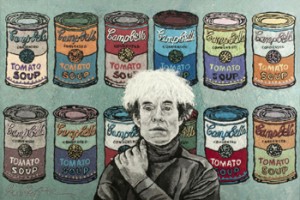
Hooper is a cancer survivor who needed to find a new outlet for her art when she could no longer make the sculptures in which she was trained. She found the unusual medium of dryer lint. Her work has since been found in galleries all over the country. She was featured in a Ripley’s Believe it or Not book, and Ripley’s has purchased dozens of her dryer lint work, which display in their museums all over the world.
After Consumer Reports did a side piece about her work and called her “The Andy Warhol of Dryer Lint,” Hooper made the large piece that won her this award.
“Many galleries refuse to take the art seriously because of the medium, so it was especially nice to be recognized by such as prestigious art award,” Hooper said.
The Niche Award program recognizes the outstanding creative achievements of American cart artists who produce work for galleries. Judging is done by art professionals and professors, and is based on three main criteria:
- Technical excellence, both in surface design and form
- Market viability
- A distinct quality of unique, original and creative thought
Winners of the 2014 Niche Award were announced recently at the Pennsylvania Convention Center.
Niche Magazine is published by The Rosen Group, a Baltimore-based arts marketing, publishing and advocacy firm. The Rosen Group produces the Buyers Market of American Craft, the nation’s largest craft show for American and Canadian artist-made merchandise, in which galleries and artists from all over the US and Canada attend.
RIPLEY’S BELIEVE IT OR NOT: DOWNLOAD THE WEIRD
“When Dust Settles”
American artist Heidi Hooper works with an unconventional medium — dryer lint! Ripley’s has bought many of Heidi’s artworks, including this radiant rooster.
BUCKS COUNTY HERALD
(August 9, 2012)
“Former Sculptor Finds New Way to Express Herself by Turning Dryer Lint Into Works of Art”
by Jodi Spiegel Arthur
When Heidi Hooper was a little girl, she used to sit in the bathtub, turning soap into works of art.
“I used to get in trouble for carving bars of soap,” she said. “My mom hated it because she was constantly having to buy soap. I was a bad kid,” she said, laughing.
As she grew into adulthood, her art evolved from soap carvings of cows and ducks to bronze and silver sculpture and wearable art costumes.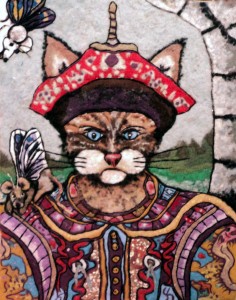
Hooper’s sculpting career was cut short in early 1999, when a cancerous desmoid tumor was discovered in her dominant arm. Multiple surgeries and radiation to combat the cancer, which recurred twice, resulted in the removal of her right upper arm muscle and severely diminished her arm strength, forcing Hooper to change the way she expressed herself.
“I wasn’t going to take it lying down,” said the 1981 graduate of Virginia Commonwealth University, who worked on her master’s degree in metalsmithing at Massachusetts College of Art.
It was by chance, and a great deal of trial and error, that Hooper hit on a new way to be creative: turning dryer lint into art.
She shows her work, most featuring animals, at galleries within a 100-mile radius of her Tannersville home, including A Mano Galleries, in New Hope and Lambertville, N.J., and customers also find her on the Internet.
Hooper’s art is so unusual, it was featured in “Ripley’s Believe it or Not” in 2010, and Ripley’s bought a number her of dryer lint creations, which are showing in their Odditoriums around the world.
Ana Leyland, owner of A Mano Galleries, said she was impressed by Hooper’s art and her attitude.
“When Heidi approached us about her work, we were fascinated, not only by the remarkable technique but the warmth, whimsy and vitality which radiate from her pieces,” Leyland wrote in an e-mail. “Of course, visitors are impressed by an artist who uses dryer lint, but as they ‘really’ look at the pieces, they get a sense of Heidi’s deep connection with the subjects.”
Faced with an overabundance of dryer lint after her mother-in-law washed colorful chenille throw blankets while she was helping to care for Hooper during her illness, the artist decided to find a way to use the fuzzy material.
She tried molding it by mixing it with paper mache, but she didn’t enjoy working with the gooey substance.
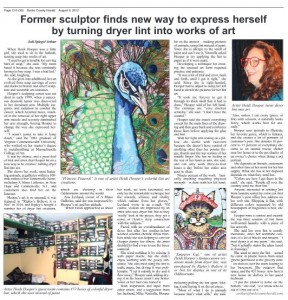 She also tried using the lint to make paper, but drying it was problematic. “I set it outside to dry and it flew away,” Hooper said, adding drying it in the house wasn’t any better: Some of her four cats ruined it.
She also tried using the lint to make paper, but drying it was problematic. “I set it outside to dry and it flew away,” Hooper said, adding drying it in the house wasn’t any better: Some of her four cats ruined it.
With inspiration and input from other artists, and a suggestion from her husband, Mike Ventrella, Hooper hit on the answer – making pictures of animals, using lint instead of paint. Since she is allergic to the smell of paint and can’t use it, Ventrella asked Hooper to try applying the lint to paper as if it were paint.
Developing a technique for creating the unusual art form required practice and patience. “It was a lot of trial and error, back and forth, until I got it right,” she said. Since she is right-handed, Hooper had to adjust to using her left hand to sketch the pictures for her lint art.
“It took me forever to get it through its thick skull that it had to draw,” Hooper said of her left hand. The etchings are “very chicken scratchy,” she said. “I don’t have the control.”
Hooper said she erases everything except for the main lines of the drawing and then goes back and reinforces those lines before applying the glue and lint.
With her right arm resting on a pillow, she works with tweezers because she doesn’t have control of anything other than her pointer finger, thumb and the top section of her middle finger. She has no feeling in the rest of her hand or arm, she said, and can only work three-to-four hours a day before her entire arm goes to sleep.
Ninety percent of the work – basically anything requiring physical strength – is done with her left hand, including pulling the lint apart, folding it and laying it on the art piece.
“Most of what I do is animals because that’s what sells,” she said. “Also, unless I cut every (piece of lint) with scissors, it naturally looks fuzzy, which works best for animals.”
Hooper uses animals to illustrate her favorite genre, which is fantasy, and she creates a lot of portraits of customer’s pets. She donates 10 percent to 15 percent of everything she earns to an animal rescue shelter near her home or to the pet charity of an owner’s choice when doing a pet portrait.
She depends on friends, customers and other fans of her work for her lint supply. What she has at her disposal depends on what they send her.
“Colors are how I get them in the mail,” she said. “People all over the country send me their lint.”
Anyone interested in sending lint from laundry sorted by color can find Hooper’s post office box address on her web site. Shipping it flat, with different colors separated by old newspapers or magazines is best, she said.
Hooper runs a contest and awards the top three senders of lint from well-sorted laundry with a piece of her artwork.
She said her own lint is mostly monotone, since her wardrobe consists of a lot of blacks and browns. “I tried dying it at one point,” she said, “but it actually stains the glass (used in framing).”
She used to store the lint – sorted by color, in plastic boxes from salad greens purchased at the grocery store – on shelves over the stairs leading to her basement. She outgrew that space, and the 457 boxes now have a new home on shelves in her guest bedroom.
“I put the (donor’s) name on the bottom,” she said, “so I know who to ask if I run out of it.”
CONSUMER REPORTS
(April 7, 2011)
“When Life Gives You Lint, Make Dryer Lint Art”
Heidi Hooper has 457 boxes of lint in her house and she’d like more. The Andy Warhol of lint, Hooper scavenges the fuzz and errant strings from the dryer to make portraits of Marilyn Monroe, Ray Charles or even your favorite pet. You can’t make this stuff up and today at the Ripley’s Believe it or Not! Museum in Williamsburg, VA, where Hooper is appearing, you don’t have to.
 A former metalworking artist, Hooper was forced to look for a different, lighter medium after suffering health problems. Then one day her dryer broke. “When I went to look there was this Peter Max-colored lump of lint about the size of a puppy on top of the dryer,” she told the Virginia Gazette. “I saved the lint because people had given me these things as gifts.” Ten years later, Hooper has several pieces on display at Ripley Odditoriums and she runs a contest on her Facebook page each year in which she gives a prize for the best lint.
A former metalworking artist, Hooper was forced to look for a different, lighter medium after suffering health problems. Then one day her dryer broke. “When I went to look there was this Peter Max-colored lump of lint about the size of a puppy on top of the dryer,” she told the Virginia Gazette. “I saved the lint because people had given me these things as gifts.” Ten years later, Hooper has several pieces on display at Ripley Odditoriums and she runs a contest on her Facebook page each year in which she gives a prize for the best lint.
Hooper would be glad to take your lint, the more colorful the better. And because lint is more apt to spark fires than creativity, it’s a good idea to remove it anyway. Each year 6,900 dryer fires cause five deaths, 220 injuries and $91.0 million in property damage, according to the Consumer Product Safety Commission and United States Fire Association. And 70 percent of those fires start in dryers that haven’t been cleaned. To reduce your risk, empty your lint screen after every load and clean your ducts at least once a year. Rigid metal ducts are less likely to allow lint build-up than flexible metal or plastic.
In Consumer Reports dryer tests we looked at the performance of built-in vent-blockage indicators, and found most to be unreliable. But we recently tested the Lint Alert, a $40 pressure sensor that you install in clean dryer ductwork, and found it was good at detecting low air flow and sounding an alarm.
That alarm would be music to Hooper’s ears. “When you’re an artist, you have this monster inside that needs to get out somehow,” she told the Gazette.
THE VIRGINIA GAZETTE
(April 6, 2011)
“Dryer Lint as Art, Believe it or Not”
by Steve Vaughan
Sometimes art can help overcome life’s difficulties.
That’s the case with Heidi Hooper, an artist from Pennsylvania whose work created from dryer lint will debut at Ripley’s Believe It or Not! on Richmond Road.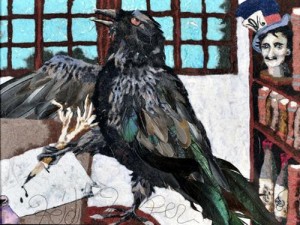
Trained as a sculptor at VCU, she made a name for herself with jewelry and costumes created from metal. She also made dolls.
“I was a master costumer. My jewelry was showing in galleries all over, and I was making a pretty good living at that,” she said. “Then I got cancer.”
She’s right-handed and had to have much of the muscle in her right arm removed, leaving the hand too weak to work with metal.
She found her new medium by accident. “When I was very sick with cancer, my mother-in-law was staying with us to take care of me. A lot of people had sent me these multi-colored chenille throws to cheer me up,” she said.
One day the dryer broke down.
“When I went to look there was this Peter Max-colored lump of lint about the size of a puppy on top of the dryer,” Hooper recalled. “Needless to say, the chenille throws weren’t chenille anymore. They were burlap rags. I saved the lint because people had given me these things as gifts and they’d been ruined.”
Later, she was looking for a way to continue her artwork.
“When you’re an artist, you have this monster inside that needs to get out somehow. Then my husband, Michael, reminded me of these pieces I’d done in college out of handmade paper. I tried that, then remembered why I hated handmade paper. Then I thought of the lint.”
That was around 2001.
“The first couple of years, they were horrible,” she laughed. “I was just relying on my own dryer.” Now she gets dryer lint in the mail from all over the country.
“I run a contest on Facebook every year where the person who sends me the best lint and the second-best get pieces of art in the mail. I?guess it’s part of the recycling that’s becoming so popular.”
Although her work looks to the eye like painting, it’s actually a kind of sculpture since the lint is placed by hand. “I’ve never really thought of it like that, but it is sculpture,” she said. Just in a softer material.
Want to go? Heidi Hooper will be at the Ripley’s Believe It or Not! Museum 3-5 p.m. Thursday, April 7. She usually donates a quarter of the profits to a local “no-kill’ animal shelter.
THE VIRGINIAN PILOT
(April 2, 2011)
“Believe It or Not, Unusual Art is Worth the Collecting”
When did the facts of Heidi Hooper’s life skew toward what Ripley would dub the “unbelievable”? That’s hard to pinpoint.
Hooper graduated from the arts program at Virginia Commonwealth University. “I always saw myself as a sculptor,” she said. It was a reasonable expectation.
She still keeps 200 pounds of sculpting wax in her basement in Stroudsburg, Pa. It is more than 20 years old.
In 1999, she developed cancer in her right arm. She lost much of the muscle in her upper arm. She lost the nerves in two fingers and parts of another. Before one surgery, she was worried she would lose her arm altogether.
Since the surgery, her work has been displayed in Alexandria and Richmond and along the East Coast. Her art includes depictions of cats and dogs and Dracula. That is a level of accomplishment, but that fact, by itself, is not unexpected.
Without the use of all of her fingers and worn down by fatigue, Hooper has given up sculpting. For the past decade, lint has been her medium as an artist, and this is where the story turns unbelievable.
When I spoke to her by phone Wednesday, Hooper said she has 457 boxes of lint in her house. It is the exact kind of lint that comes from the dryer, that gets stuck in your belly button, that is composed of your bedspread, favorite T-shirt and, grossly enough, your hair. This has all the makings of a reality-show oddity.
She has so much lint in her Pennsylvania home because people send it to her in the mail. One woman from California, a complete stranger, sent her envelopes of lint with no return address for a year. The boxes are sorted by color. She has 30 boxes alone to cover the narrow spectrum from tan to brown.
Hooper sketches birds and cats and dogs and Marilyn Monroe and, as if they were paint-by-number worksheets, colors them in with pills of lint. When she first tried showing her work, the galleries she approached were disgusted.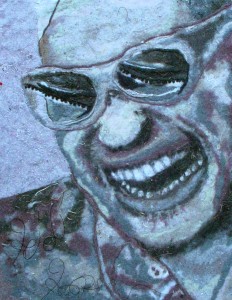
“Dryer lint?” they asked? “Yuck. No.” That fact is 100 percent, absolutely believable.
At art festivals, Hooper would stand outside her exhibit as people guessed that her artwork was fashioned from acrylic or handmade paper, and she would watch their amazement when they learned that the detail work and texture came from the clothes they were wearing.
Today, her smaller works sell for hundreds of dollars. They have won accolades and judges awards at art shows and science-fiction conventions. But eBay has proven there’s a market for everything – so, again, that is believable.
Thursday, Hooper and her art will be on display at the Ripley’s Believe It or Not museum in Williamsburg. She will put on a short demonstration, until her right arm becomes too fatigued to work any longer.
There is something ordinary and expected about Hooper’s story, a familiar thread to the narrative that we take for granted. A woman with cancer survives and makes artworks from an unexpected medium and sells them for hundreds of dollars.
It doesn’t strike me as completely unbelievable. Bizarre, yes. Quirky, sure. A bit unhygienic, if your lint trap looks anything like mine. But it is plausible.
“The art culture has changed,” Hooper said. “So much more is accepted now than it ever was.”
And maybe that is what is most shocking about Hooper’s opening this week: we are not so easily shocked.
“There are things you can see on YouTube that are a lot more disturbing than what you’ll see in my museum. And I’m OK with that,” said Scott Hart, the general manager of the Ripley’s in Williamsburg.
A rendering of Ray Charles, made of threads scavenged from our dryers, from the smallest pieces of our socks and towels? Oh? That’s nice.
The unexpected, the unbelievable, the unthinkable happen every day, and we take them for granted. We believe it more often than not.
POCONO RECORD
(November 22, 2010)
“Life as the Dryer Lint Lady”
For most people, laundry is nothing more than an everyday task. For Heidi Hooper of Stroudsburg, an excess of laundry has become more artform than chore.
Hooper is known as the “dryer lint lady” and is featured in Ripley’s “Believe It or Not” book, “Enter If You Dare,” for her unusual dryer-lint art, which she creates using only one arm.
In 1999, her career as a silversmith was cut short when she was diagnosed with a rare cancer called Desmoid Tumor.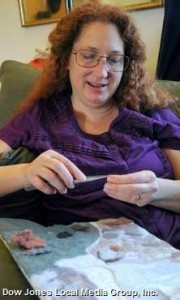
She had to give up her work after her first big operation. Radiation treatments were so invasive that they ate away two tri-muscles (the skinny muscles under the bone) in her right arm, which was basically liquefied.
Ripley’s “Believe It or Not” features people who have “strange” and “unusual” talents, so Hooper has mixed feelings about being in the book.
“It reinforces the idea that I’m a ‘freak’ and not an artist,” she said. “There is a different artistic philosophy going on with what I do.”
She has a bachelor’s degree in sculpture with a minor in art history and a master’s degree in foundry.
Hooper received her placement in the book for being the only person in the world working with dryer lint using a flat picture.
First, a picture is drawn on a mapboard and dryer lint is slowly added. It is held on with tacky glue and eventually sticks to itself from the pressure.
“The lint comes from all over the country,” Hooper said. “I don’t know who most of the people are who send me dryer lint. They read about what I do online and send it in.”
She has 425 boxes of color-coded dryer lint in her house. Hooper said the boxes are lined up all along the hallway going downstairs, and also above her dryer.
“I am starting to run out of room,” she said, laughing.
The cancer has prevented Hooper from doing the silversmith work that she once loved. She explains that it gradually became more and more painful to hold the hammer.
“Right before the operation I wasn’t sleeping well because the pain was so bad,” she said.
Hooper goes to the University of Pennsylvania hospital for treatments.
“There was serious nerve rerouting in order to use my hand, and I am numb from the last two fingers on my hand and up,” she said. “Muscle was taken out of my back to protect the bone in my arm. If I were to fall, the bone would shatter.”
Hooper got started using dryer lint after some chenille throws were accidentally washed and there were huge piles of colorful fluff.
After trying several media to still remain an artist, she decided to separate the lint into cardboard boxes and give this a try.
“Being an artist is all I know, and there aren’t many choices for me, given my situation,” she said.
The limitations with her right hand due to cancer have caused Hooper to use long-nosed tweezers to make her art. One thing she found was if the lint gets wet, it sticks everywhere.
When Hooper brings her work to galleries, she usually shows between 12 and 15. The pieces generally fetch from $200 to $400.
Some proceeds are given to animal rescues, particularly Creature Comforts in Saylorsburg. Hooper and her husband live with several cats, and she says the cats have been a great comfort throughout her struggle with cancer.
“We always knew when the cancer was back,” she said. “I had a cat who would lay its paw on top of my arm and every time I turned around the cat was next to me. This happened every time the cancer returned.”
Despite her obstacle, Hooper pushes forward and remains optimistic.
“I was only able to take so much depression from the cancer before I forced myself to get up and continue going,” she said.
RIPLEY’S BELIEVE IT OR NOT: ENTER IF YOU DARE!
(August 2010)
“Lint Lady”
Heidi Hooper, from Massachusetts, uses dryer lint to create images of animals. The lint is taken from the cotton fiber in towels, chenille from throw blankets and feathers from down comforters that have been through the dryer. Unfortunately, the lint cannot be dyed to a specific color, as it is basically dust, so it can be a difficult task creating a color palette. Heidi will sometimes buy towels in the colors she wants to make her work a little easier.
ARTS IN THE VALLEY
(March 2009)
POCONO RECORD
(April 2, 2006)
“Stroudsburg artist aims for unusual, using dryer lint”
Stroudsburg artist Heidi Hooper, who makes photographic-like artwork using dryer lint, as well as sculpted dolls, sells most of her work in urban areas — such as Boston and New York, where art has to be different to find a buyer.
However, DM Studios in Marshalls Creek, operated by Donna McCartney and Jasmine Abrams, will change all that.
This new gallery is receptive to all sorts of art and will feature the work of Hooper as well as many established artists and fledgling younger artists trying to make a name for themselves.
“Jasmine has always been very honest and straight-forward in her interest in artwork that is not in the traditional norm,” Hooper said. “A lot of artwork here in the Poconos tends to be the same because you are selling to tourists, who are looking for the traditional. In the big-city galleries, they are looking for something different.”
Hooper also noted that people on vacation are more likely to spend $20 on an item than write a check for a pricier piece of art. This is another reason that artists cater to the tourist art trade to make their bread and butter, and this usually translates to traditional artforms, such as landscapes and florals.
“I’ve never been the one for the traditional,” said Hooper, who was a metalwork artist prior to a bout of cancer that limited the use of her right arm.
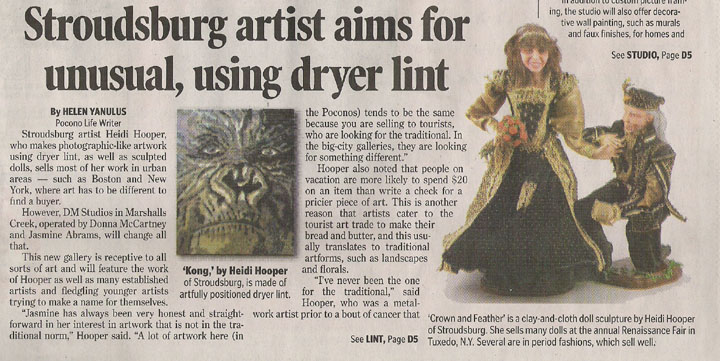 In the new gallery, visitors will be treated to many types of artwork as well as the owners’ murals and faux finishing services, and the custom framing work.
In the new gallery, visitors will be treated to many types of artwork as well as the owners’ murals and faux finishing services, and the custom framing work.
“I think they will look for more than what is going to sell, look for something different, unusual and cause people to go in and look to admire art,” Hooper said.
When Hooper’s illness limited what she could do as an artist, she tried painting, but quickly remembered how much the fumes bothered her.
Her mother-in-law’s laundry habits actually heated up an artistic idea for Hooper.
Her mother-in-law came to stay with Hooper to help out. Friends had given Hooper colorful chenille throws to add cheer to the day. But Hooper’s mother-in-law washed and dried the throws to the point that they disintegrated into dryer lint.
“I had these really nice primary colors in lint. I was cherishing the throws because it was such a nice thing for people to do for me, so I kept the lint in boxes,” Hooper said.
As the lint collection grew, Hooper decided to try working with the fluff to create abstracts and then human figures. Eventually, she settled on taking photographs, projecting the image on a board, tracing it and then coloring with lint by using tweezers to apply the lint.
The whole piece is held in place by the frame and glass, which means many projects blew away before she was able to finish the artwork.
Hooper told others that she would make a work of art if they would send her lint. Many sent lint and didn’t ask for anything in return. She now has 120 boxes of lint that are color-coded.
“I’ve got so many boxes of dryer lint that I can almost get painter’s shading,” Hooper said.
The toughest color to find is orange.
“People just seem to like it,” said Hooper, who is represented by A Mano Gallery in New Hope.
She knows of only two other artists working in this medium, mainly creating landscapes. “I think I’m the only one doing it at this scale,” Hooper said.
Many people commission portraits of their pets. One person gave her the lint from her dryer that included the pet’s fur that had shed onto the clothing.
“My view is to expose people to different kinds of stuff,” she said.
Her dolls, created from ProSculpt clay, are reflective of the people she meets. She sees an interesting face and asks the person if she can take their photograph.
“These are basically portraits of real people,” Hooper said.
With a clay face finished, she will create an appropriate costume.
She sells many dolls at the annual Renaissance Fair in Tuxedo, N.Y., during the late summer. Several of the dolls are in period fashions, which sell well.
Hooper said, “I try to make it as realistic as possible so that it seems that it is going to get up and walk towards you.”
POCONO RECORD
(April 30, 2004)
“More than just a pretty face”
Strolling musicians, fine crafts and works of art, like this sculpture by Heidi Hooper, will enhance an Evening on Main, Stroudsburg.
POCONO RECORD
(April 27, 2004)
“Walking stiff”
Heidi Hooper of Stroudsburg was quite a sight carrying her sculpture down Seventh Street to the Monroe County Arts Council Monday afternoon in Stroudsburg. Rachel Cohen, a MCAC volunteer, helped Hooper tote her creation, which she calls Ralph. It is made from, among other things, steel, bubble pack, paper clay and clothes. Artists swarmed MCAC Monday to drop off their work for Evening on Main, which happens this Saturday.
POSTSCRIPT
(January 5, 2001)
“Winter Blues”
The thing about a theme show such as Winter Blues is that it is a challenging, fun thing. Heidi Hooper has been showing her sculptures in bronze and polymer clay since 1975. Her entry is “Cat Blue” with cats climbing around on branches. She studied sculpting in college.
POCONO RECORD
(September 24, 2000)
“New Creation”
Only ones with a heart of steel will make it. Heidi Hooper, a sculptor and metalsmith, should know. She studied art and has degrees from Virginia Commonwealth University and Massachusetts College of Art.
As a child growing up in Virginia, she was sent to art classes where every instructor asked participants to do the same thing for every class. Drawing trees was one of the favored exercises.
“I don’t want any kids to go through that. It almost soured me on the arts. If I didn’t have that little monster inside me wanting to create, it would have,” Hooper said.
THE BOSTON PHOENIX
(May 24, 1991)
“This Weekend”
“Pretty” is not how local metalsmith Heidi Hooper would like people to describe her weird bronze creatures, suits of armor, and sculptured bones, all of which are meant to get the censorship squad’s blood pressure up. Her works are included in a show called “Off Color” at MassArt’s Huntington Gallery.
THE ENCYLCOPEDIA OF AMERICAN ARTISTS
(1989 edition)
“Heidi Hooper”
BFA in Sculpture and jewelry from Virginia Commonwealth University. Presently showing in Boston galleries including Goldsmith Copley Place. Works are primarily in silver with precious stones. Each piece is designed with “my hand firmly on the torch and my tongue firmly in my cheek.” Works include pins, pendants, and boxes, each one individually designed.
PRELUDE MAGAZINE
(May 1987)
“Heidi Hooper: Silvered Smiles”
At age 28, silversmith Heidi Hooper is still watching cartoons and playing Dungeons and Dragons. And when she misses the cartoons on Saturday morning, friends tape them. Along one wall stands a bookcase full of tapes — which also includes oldies of the Marx Brothers, or Betty Boop, Popeye and Fleischer cartoons — are in jackets rainbow colored by magic markers. Looking around Hooper’s third floor Boston Apartment — noticing a metal tray with youthful faces of the Beatles — it becomes easier to understand the source of her unusual art.
Hooper, with the playful imagination of an animator and the artistic training of a sculptor, is quickly becoming known for her whimsically humorous silver pins. The pins, which measure about two inches square, depict tiny scenes played out on a sterling silver stage.
“I try to make a portable sculpture — a piece of art within a piece of art, rather than something that is just there to look at,” says Hooper. “Most jewelry is just there to reflect something about the person wearing it, but I try to evoke something beyond ‘Don’t I look great in this!'”
One of Hooper’s favorite pieces is a pin called “Pork Roast.” In it, several tiny pigs stand atop a roasting pan, giving speeches from a podium. Often her characters are a mix of human and animal. The scenes capture a single, suspended moment of ironic activity: a cow stakes a furnace with a coke bottle; Fred Astaire dances with a turtle; a pig dances in a chain mail tutu; a man eats dinner with a rabbit; a crab tutors another crab. They are often very funny.
“I like things that seem normal but are not really normal at all,” says Hooper, who uses pigs, frogs and turtles most often in her work. “Anything that is tongue-in-cheek, I love.”
Hooper, who also makes silver earrings and silver boxes, produces about 50 pins a year, which are sold at the Goldsmith in Boston and in galleries in the south and west. The pins sell for $200 to $350, earrings sell for $12 to $30, and the boxes sell for $500 to $1000.
Raised in Richmond, Virginia, Hooper studied at Virginia Commonwealth University art school, majoring in sculpture. In school, Hooper first worked with matress stuffing to create larger-than-life human figures, a far cry from her current miniature silver pieces.
“During one semester at school,” says Hooper, “my work shrank from six feet to six inches.”
Toward the end of her schooling, Hooper began making decorative silver boxes. She decided three years ago to make wearable pieces. This decision led first to a series of pendants, and then to pins. The first pins, she says, were designed at puppet-show stages and were less imaginative than her current work.
In developing scenes for the pins — which are one-of-a-kind — Hooper began to draw on her fascination with cartoons and the human qualities given in them to animals.
“I always find — and maybe it’s because I am a vegetarian — that animals are very human,” says Hooper. She explains in a playful voice that in our strictly realistic way of looking at animals we impose unimaginative limits. “‘You’re a goat. You can’t do that,'” she mimics. “But if tis wasn’t real-life a goat probably could do that — whatever that is — if it had enough brains.”
It is that one step beyond “real-life” that makes Hooper’s scenes so unique — like a pig riding a bicycle. The second step is the actual moment she captures on the pin: a single, frozen moment, like one frame in an animator’s strip: a lady kicks up her feet as she dances with a centaur.
“I’m trying to make a freeze-frame that you wear,” explains Hooper. “That’s why they’re on a stage — it’s as if they are part of a play. And I try to incorporate some sort of movement so that it looks like they’re moving, even though they’re not.”
Hooper works in a small kitchen pantry which serves as her studio, but only some of the work is done there. In the studio she carves the elements of the imagined scene from wax. She then takes the wax pieces, attaches sprews, or small holding sticks, and places them into a cylinder filled with plaster. The cylinder then fits into a centrifuge at a friend’s Boston studio. In the warmed centrifuge a cast is made of the wax figures, which melt and drip out, leaving a hollow, fine plaster cast. Molten silver is then injected into the cast to form the figures for the scene. Back at her studio, Hooper arranges these figures onto a stage that she makes in advance. The figures are soldered into place, details filled in, and the piece polished.
Over the past three years, Hooper has seen her work become freer and more comical. She says she tries to draw casual observers into her pieces — and offer them more than something merely “interesting.” She wants to see them smile and enjoy the humor of the captured moment.
Hooper wants the audience to respond as if they were observing a live performance. She recalls the words of one of her professors who warned against the dangers of a metal, such as silver, which is naturally beautiful: “If you’re dealing with a pretty metal, then you have to work the hardest — you have to fight the ‘pretty’ to make it interesting. There has to be something to make you think about the piece after you’ve left it. Otherwise, you’re just making pretty objects.”
With this warning in mind, Hooper has set out to create engaging jewelry. having mastered the pin, she soon hopes to transfer the narrative scenes to earring sets and necklaces. For one future project, she plans to make a Romeo and Juliet jewelry set — earrings, necklace, and pin — of a rabbit and a goat at various stages of their wooing, romance, and late-life marriage.
But for all her efforts to make engaging art, Hooper insists she’s not trying to make a statement. “I am interested in the arts because I enjoy doing it — I have never tried to make statements,” says Hooper. “Twenty years from now people will have a different opinion of the work, so why try to impress your opinion of it? Why not do it just because you enjoy doing it?”
THE CITIZEN ITEM
(April 17, 1987)
“Humor, Art Set Jewelry Apart”
A turtle dancing with Fred Astaire, a frog crooning to a voluptuous woman, and a cow stoking a furnace with a coke bottle are not the images that inspire most jewelry designers. And that’s just fine with Heidi Hooper.
To Hooper, a Brighton resident, the distinctiveness of her work — primarily silver brooches and pendants — is its most appealing feature.
“Everybody does jewelry that looks like jewelry,” she says. “But nobody does anything like mine. Twenty years from now people will look at it and say ‘Hey, that’s really interesting’ rather than ‘Oh, that was done in the ’80s.'”
She quickly adds with the hearty, self-effacing laugh that often bursts forth during her conversation, “But then, I like the weird things in life.”
She traces her affection for the offbeat to the influence of sculptor Joe Seipel, one of her art teachers at Virginia Commonwealth University. Her favorite Seipel creation is a tongue-in-cheek piece depicting what at first glance appears to be a fish with a hook in its mouth. Upon closer inspection, though, the viewer discovers that the fish is actually reeling in an old boot.
“His big thing was that if you’re using pretty materials, you’ve got to make the people notice the piece first,” she explains. “In most metal work, you notice the sparkle before the design.”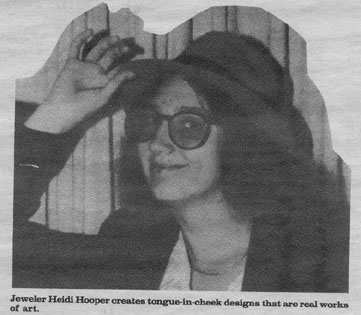
To add to the allure of her own designs, Hooper uses miniscule three-dimensional animals in unlikely postures. A cartoon aficionado, she asserts that the comic potential of animals in her creative wellspring and drawing from it adds to the visual experience.”
“I love using animals,” she says. “They’re really intriguing sculpturally. It’s normal to see a person on a bike, but when you see a big fat pig riding one, it’s different; it draws you in more.”
Hooper maintains that, once the eye is caught, the imagination flourishes. As she suggests, one has the feeling that the tiny figures stopped their activity when they realized that they were being watched, and that they might suddenly resume it. At times, this fantasy actually comes true — in one piece a rabbit’s oversized head jiggles as he eats dinner with a man, and in another, a well bucket rises with a tiny crank.
Nurtured by teachers who encouraged creativity of this sort, Hooper spent years developing her style. After graduating from art school, where she majored in sculpture and jewelry making, she moved to Boston and worked at a succession of jobs — diamond inspection, earring production, and jewelry repair. She tried with limited success to market her own line of “typical el-cheapo” earrings, but eventually decided to follow her art — and her heart — and began concentrating her efforts on less conventional jewelry. These efforts were hampered by a lack of retail know-how and the reluctance of gallery owners to take a chance on such unique merchandise.
“A lot of places in Boston cater to the easy sell,” she contends. “If they don’t know it will make them money, they are not interested. Others would say ‘Well, I’m not sure…’ and I would start packing up my things to leave. I thought the pieces would sell themselves; I didn’t know I had to make a sales pitch.”
Hooper’s breakthrough finally came when the owner of the Goldsmith, a Copley Place gallery, commissioned her to make ten brooches.
“I was shocked,” she recalls, punctuating the memory with a laugh. “I’m still shocked.”
Even more astounding to her was the price range he suggested — $125 to $200 wholesale and $200 to $400 retail.
“But people are buying them,” she says, the disbelief evident in her voice. “They seem to think the price is reasonable.”
Hooper explains that the special title she engraves on the bottom of each piece — another expression of her whimsical humor — has been an inadvertent boost to sales. The first piece she sold, which depicted a slightly inebriated elderly gentleman conversing with a chicken and a cow, was entitled “Uncle Bob and Friends.” A customer from New Hampshire thought it would be the perfect gift for her Uncle Bob who just happened to be a farmer.
Hooper’s work was recently highlighted in Prelude, a national fashion magazine, and it will soon be sold in galleries across the country. Despite the attractiveness of such notoriety and commercial success and the laborious, time-consuming process of casting the jewelry, Hooper is adamant in her determination to maintain the integrity of her art.
“These are my babies,” she says, fondly examining a brooch. “They’re really precious to me. I’ve never in four years made one that looked like another.”
She continues, “I feel good about what I’m doing. I still feel like I’m producing art and not just objects. I don’t think I’ll ever change — if anything, I’ll just get worse!”

